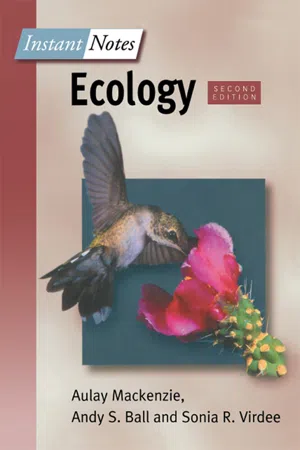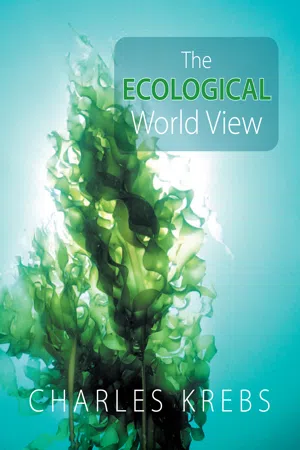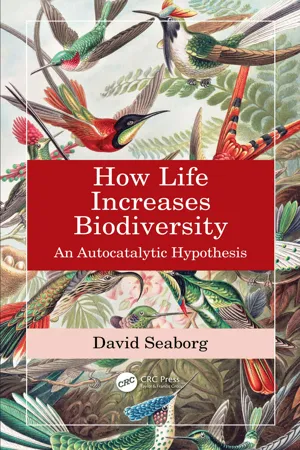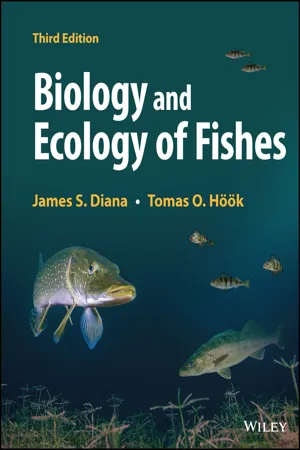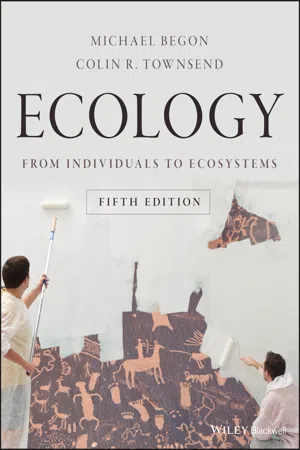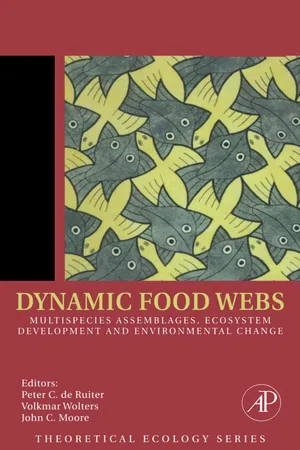Biological Sciences
Competition and Predation
Competition and predation are two important ecological interactions. Competition occurs when organisms vie for the same resources, such as food or territory, leading to a struggle for survival. Predation involves one organism consuming another for food, shaping the population dynamics and evolutionary adaptations of both predator and prey. These interactions play a crucial role in shaping ecosystems and maintaining biodiversity.
Written by Perlego with AI-assistance
Related key terms
Related key terms
1 of 4
Related key terms
1 of 3
7 Key excerpts on "Competition and Predation"
- eBook - ePub
- Aulay Mackenzie, Andy Ball, Sonia Virdee(Authors)
- 2020(Publication Date)
- Taylor & Francis(Publisher)
Section I – CompetitionI1 THE NATURE OF COMPETITIONKey NotesClassifying interactionsInteractions between individuals and species can be classified on the basis of the effects and the mechanism of the interaction. The key interspecific interactions are competition, predation, parasitism and mutualism, whilst the main intraspecific interactions are competition, cannibalism and altruism.CompetitionCompetition is an interaction among individuals utilizing a limited resource, resulting in reduced fitness in the competing individuals. Competition occurs both between species utilizing a shared resource (interspecific competition) and among members of a species (intraspecific competition). The niche of an individual or species (the conditions under which it is found, the resources it utilizes and the time it occurs there) is critical in determining the degree of competition with other species or individuals. Large niche overlap generally results in intense competition.Intraspecific competitionAs individuals are quite similar in their resource requirements, such competition may be particularly intense. Intraspecific competition is a major force in ecology and is responsible for phenomena such as dispersal and territoriality, as well as being the primary cause of population regulation via density-dependent processes.Interspecific competitionInterspecific competition occurs between two species using the same limited resource. Very few species can escape from the effects of other species competing for the same resource. Exploitation competitionThere are two ways in which competition can operate. In exploitation competition, individuals only interact indirectly, by depleting the resource in short supply. Reduced fitness occurs due to a shortfall in resource availability.Interference competitionIn interference competition, individuals interact directly, most obviously, in the case of some animal species, by fighting, but also by producing toxins (e.g. plant allelopathy). Fitness reduction in the ‘loser’ in such interactions may be due to the interference (e.g. injuries or death) as well as the lack of resource access. - eBook - ePub
- Charles Krebs(Author)
- 2008(Publication Date)
- CSIRO PUBLISHING(Publisher)
Populations of a single species are not found alone in nature. Rather, they exist in a matrix of many populations of other species. Although some species in an area will be unaffected by the presence or absence of one another, in some cases two or more species will interact. The evidence for such interactions is quite direct: A population of one species changes when a population of a second species changes. We are concerned here only with direct interactions between two species. Ecologists classify interactions on the basis of their effects, which may be negative or positive.In negative interactions, one or both of the species involved suffer some loss, either in population size, reproduction or mortality. There are five types of negative interactions between individuals of different species:• Predation: one animal species eats all or part of a second animal species.• Herbivory: one animal species eats all or part of a plant species.• Competition: two species use the same limited resource or harm each other while seeking a resource.• Infection: a microorganism lives in or on a host and impairs the physiological function of the host.• Parasitism: two species live in a physically close and obligatory association in which one (the parasite) depends metabolically on the other (the host).Positive interactions are grouped into two large categories:• Mutualism: Two species live in close association with each other to the benefit of both.• Commensalism: Two species are closely associated—one draws a benefit while the other is unharmed.We will discuss infection and parasitism in Chapter 8 and mutualism and commensalism in Chapter 9. In this chapter we will focus on how the first three negative interactions—predation, herbivory and competition—affect the distribution and abundance of the interacting species.7.2 PREDATION IS THE PRIMARY FACTOR LIMITING THE ABUNDANCE OF MANY POPULATIONS
Predation is an important process from two points of view. Firstly, predation may restrict the distribution of a species (as we saw in Chapter 3) or reduce its abundance. If the prey is a pest, we may consider predation useful because it makes the pest less common. However, if the prey is a valuable resource, such as caribou or domestic sheep, we may regard predation as undesirable because it causes an economic loss or a conservation problem. Secondly, predation is a major selective force in evolution, and many adaptations we see in organisms, such as warning coloration, have their explanation in the evolution of predator–prey systems. - eBook - ePub
- Simon A. Levin, Stephen R. Carpenter, H. Charles J. Godfray, Ann P. Kinzig, Michel Loreau, Jonathan B. Losos, Brian Walker, David S. Wilcove, Simon A. Levin, Stephen R. Carpenter, H. Charles J. Godfray, Ann P. Kinzig, Michel Loreau, Jonathan B. Losos, Brian Walker, David S. Wilcove(Authors)
- 2009(Publication Date)
- Princeton University Press(Publisher)
For instance, coyotes (top carnivores) feed on other predators such as foxes (mesopredators), both of which consume rabbits (herbivores) and opossums (omnivores). When predators consume other predator species, the act is called intraguild predation, whereas cannibalism occurs when predators consume members of their own species. Wolf spiders (Lycosa and Pardosa), for example, are notoriously cannibalistic, consuming smaller individuals in the population and even their own offspring. Although many predators are generalists, feeding on a diversity of prey species, there are some very specialized feeders. Desert horned lizards (Phrynosoma platyrhinos) are ant specialists, and ground beetles in the genus Scaphinotus feed selectively on mollusks and have a long head and mandibles adapted for reaching deep into snail shells. Predation can have widespread ecological, evolutionary, and economic effects on biological communities in both natural and managed habitats. Predation, for instance, can be a powerful evolutionary force with natural selection favoring more effective predators and less vulnerable prey. In an ecological sense, predators can dramatically affect the abundance and distribution of their prey populations. Moreover, the diverse feeding habits of predators form linkages that are responsible for the flow of energy through food webs, thus affecting food-web dynamics. Predators can act as keystone species, preventing superior competitors from dominating the community and promoting biodiversity at lower trophic levels. In contrast, the invasion of native ecosystems by exotic predators often has very negative effects on resident prey species. On a more positive note, invertebrate predators have been used as effective control agents of agricultural pests, increasing crop yields without the adverse consequences of pesticides - eBook - ePub
How Life Increases Biodiversity
An Autocatalytic Hypothesis
- David Seaborg(Author)
- 2021(Publication Date)
- CRC Press(Publisher)
9 Predators and Prey, Parasites and HostsMutualistic Relationships That Create High Diversity
Predators maintain and increase the biodiversity of their ecosystems. Predation is traditionally viewed as a relationship in which the predator benefits at the expense of its prey, which is negatively impacted. While the predator obviously benefits, the view that predation has only deleterious effects on the prey is overly simplistic. Reality is more complex. Predators are bad for individual prey animals that are consumed. But predators aid many of the prey animals that escape them, by reducing the intraspecific competition they would otherwise face. In fact, the predator-prey relationship is mutualism rather than the predator benefiting at the prey’s expense, since the overall effect of predation on the prey population and species is positive, even though some individuals of the prey species are killed or injured. From the viewpoint of the individual prey that is eaten, the interaction is antagonistic, but from the viewpoint of the prey population or species, it is mutualistic. The reasons follow.The most significant way that its population. This prevents the prey from over-exploiting its environment. Any unchecked population has the capacity to—and in fact will—exhaust its food supply, eating it until there is nothing, or close to nothing, left. This will cause the members of the population to starve to death. The prey will also become overcrowded, with too little space to persist. This tendency of a population to deplete its resource base is fundamental to the ideas of Malthus [1 ], and is one of the fundamental tenants of Charles Darwin’s theory of evolution by natural selection.Malthus correctly stated that populations grow exponentially and can out-grow their food supply if they are not regulated, An unregulated population will deplete its resources—food, water, land, and so on—from its sheer numbers that result from exponential growth imposed on finite resources. An unchecked population in exponential growth will also pollute its environment with excessive production of metabolic waste products. So any population that lacks regulation will in time decline precipitously or go extinct, from starvation, lack of space, and its waste products. Excessively large populations of organisms degrade their environment in other ways as well. For example, if there are too many hoofed herbivores, they will compact the soil beyond the capacity of other species to undo the damage, with the result that few if any plants can grow. The environmental degradation caused by an excessively high population of any species will greatly negatively impact many other species. - eBook - ePub
- James S. Diana, Tomas O. Höök(Authors)
- 2023(Publication Date)
- Wiley(Publisher)
PART 4 Feeding and PredationPassage contains an image
CHAPTER 17 Predation and Foraging BehaviorSome population processes, such as competition, critical period, and density dependence, were addressed in earlier chapters. The major factor influencing mortality of most fishes is predation. Since predation is such an important process structuring fish communities, both direct (related to the predator) and indirect (related to the prey) effects are important to a predator’s success. The purpose of this chapter is to review the overall process of predation and to examine examples of different predator tactics to capture prey, as well as some prey responses to avoid being captured. Predation plays a very important role in population regulation of prey species.Predation includes a suite of behavioral, individual, and population effects. Individuals may respond to changes in prey density by eating more of a particular type of prey. The predator population may respond directly by migrating to an area to feed or staying in an area longer, resulting in higher predator density. Since individuals in that area have more food to eat, they should have greater success in rearing young, and there should be more young in the area. These behavioral responses can be translated into population responses. Responses may occur over several years or very quickly as predators continue to move to other areas where there is more food. This chapter develops ideas on predatory interactions and mainly focuses on the foraging behavior of individual predators.Components of Predation
C.S. Holling, an ecologist from the University of British Columbia, evaluated the complexity of behaviors involved in predation. Several behaviors are involved in predatory decisions, and these behaviors are often sequential. The sequence may include at least five components:- Patterns of search – whether animals actively search or wait motionless for prey.
- Encounter of prey – being able to recognize a prey item. This may mean overcoming cryptic coloration, or being able to detect prey in an environment that might not be very clear visually.
- eBook - ePub
Ecology
From Individuals to Ecosystems
- Michael Begon, Colin R. Townsend(Authors)
- 2020(Publication Date)
- Wiley(Publisher)
One obvious omission from the predator–prey interactions in our basic models was any acknowledgement that prey abundance may be limited by other prey, and predator abundance by other predators. Prey are bound to be increasingly affected by intraspecific competition as their abundance increases. Predators, too, are likely to be competing for, not simply preying upon, their prey, as well as being limited at high densities by the availability of resting places or safe refuges of their own.mutual interferenceMore specifically, predators have been assumed in the models discussed so far to consume prey at a rate that depends only on prey abundance. In the Lotka–Volterra model, for example, the consumption rate per predator is simply aN, and consumption rate with a type 2 functional response is aN/(1 + ahN). Typically, however, consumption rate will also often depend on the abundance of the predators themselves. Most obviously, food shortage – the abundance of prey per predator – will commonly result in a reduction in the consumption rate per individual as predator density increases. However, even when food is not limited, the consumption rate can be reduced by a number of processes known collectively as mutual interference (Hassell, 1978 ). For example, many consumers interact behaviourally with other members of their population, leaving less time for feeding and therefore depressing the overall feeding rate. For instance, hummingbirds actively and aggressively defend rich sources of nectar and spend more time doing so the more competitor hummingbirds there are. Alternatively, an increase in consumer density may lead to an increased rate of emigration, or of consumers stealing food from one another, as do many gulls. All of these mechanisms give rise to a decline in predator consumption rate with predator density. Figure 10.9 a, for example, shows this when the crab Carcinus aestuarii forages for the mussel Musculista senhousia. Figure 10.9 b shows that the kill rate of wolves, Canis lupus, preying on moose, Alces alces - eBook - ePub
Dynamic Food Webs
Multispecies Assemblages, Ecosystem Development and Environmental Change
- Peter C de Ruiter, Volkmar Wolters, John C Moore(Authors)
- 2005(Publication Date)
- Academic Press(Publisher)
There is now enough evidence that both components of food webs need to be reconsidered and utilized approaches to be revised in future work. Populations are usually described only through reproduction and mortality. But populations consist of individuals that grow and develop and not all predator and prey individuals are identical (see De Roos and Persson, Chapter 3.2). Life history variation among species, expressed as different generation times influences population growth (see Scharler et al., Chapter 8.3). Predation pressure may induce defences to some of the individuals of the population of their prey, creating heterogeneity in the prey population (see Vos et al., Chapter 3.4). Traditional approaches ignore the dynamics resulting from the previously described aspects of heterogeneity within the populations. This missing heterogeneity may be an important determinant of the observed pattern and processes on food webs and community level properties such stability, resilience, and persistence. One of the valid criticisms that have been developed is that interaction between species can be described by a linear function of their densities (Pimm, 1982). This is the ecological equivalent of the Law of Mass Action that has been inherited to younger Ecology from older Chemistry. Applied to community processes, this law states that if the individuals in populations mix homogeneously, the rate of interaction between two species is proportional to the product of the numbers of individuals in each of the species concerned. As a result, predators for instance keep consuming their prey independently of their density, which certainly cannot be true in real systems. Responding to the call for more mechanistic models, Fretwell (1977) and Oksanen et al. (1981) studied food chains representing interactions that accounted for functional and numerical response of predators
Index pages curate the most relevant extracts from our library of academic textbooks. They’ve been created using an in-house natural language model (NLM), each adding context and meaning to key research topics.
Explore more topic indexes
Explore more topic indexes
1 of 6
Explore more topic indexes
1 of 4
